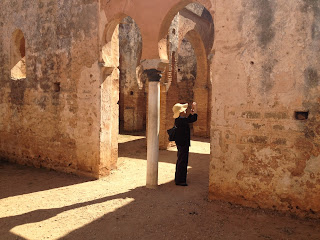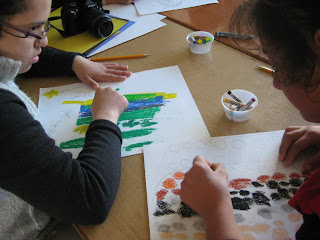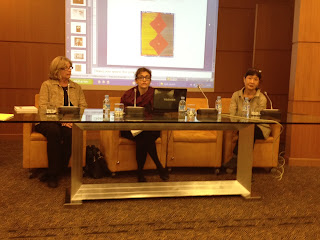After a day wandering through the medina, negotiating three languages: English, French, and Moroccan Arabic with children at the Fondation and going to conferences until 9 pm at the Villa des Artes, the humble bathroom in Rm 6 at The Splendide is a private spa. Despite cracked and yellowed tile, peeling paint and rusty water pipes, this tiled room with a depression in the tile below the shower wand is a welcome retreat to take a hot sponge bath and use some of the argan oil soap Hilda and I got in the medina. This was our best lesson in bargaining in the market. This oily green slimy looking stuff was marked 20 dh and while we stood there debating how far to go down with the salesman, a local girl walked up, handed him 5 dh and he scooped a bagful of it out for her. It smells a little funny, but leaves your skin incredibly soft.
Argon oil soap
On Tuesday morning before our work, Helene took Hilda and me on a long walk on Avenue Mohammed V toward Chellah. We passed by the King's Rabat palace with it's high white walls and numerous ministries for the government. All along the avenue were orange trees full of fruit.
Walls of the Palace
We crossed a major highway to reach Chellah which is in a large park surrounded by ancient fortified walls. In the park outside we see egrets, which Helene says are called, "Abou d'Erden" meaning grandfather of Erden. There are also Crown of Thorns bushes like the same which were used to crown Christ at the crucifixtion. We make our way in through the ancient bab to the fortified wall.
Abou d'Erden
Crown of Thorns
Chellah is the original site that was settled in Rabat. First by the Phoenicians, then by Romans who called it Sala Colonia and then abandoned it in the 11th century for land across the river which became Sale, which is now a city where, Helene tells us, many more of the women are veiled. In the 14th century a sultan built tombs in Chellah.
Tombs of Holy Men
Storks
Roman ruins
In the medina we hunt down a cable for the computer to do conference presentations that night. You can get just about anything in the medina. You just need to know where. Helene shows us where the little art store is in case we run low at the Fondation.
Tuesday we actually have children to work with. There are more of us than there are them, but no matter. Eight teenagers from a program for the developmentally disabled. Their teacher is a lovely Moroccan man who takes them out on trips to the city in order to further their communication and social skills. They are asked to make a picture of their "favorite place" and he translates for us. The director of the Fondation has kindly given me permission to reproduce some of the images here from our workshop.
The teacher has brought a Moroccan friend who lived in NY city for many years, to help with translation and some lively discussions ensue about what different words mean in French and Arabic.
Shnou smitok? = Comment tu t'appelle? = "What's your name?" Shokrun = Merci ="Thank you." Mezien = Bien = "Good."
Many of the children make pictures from their lives: Chefchaouen - a village below the Rif Mountains, which has many blue walls:
Drawing Chefchaouen
An apartment building with many windows,
Pictures of family and gardens. Another subject: the Bab al Had - the main door to the medina in Rabat, near where the children's school is located:
Drawing of the Bab al Had door to the medina
They use oil pastel and the drawings are very detailed or simple according to their developmental abilities just as with kids everywhere. One very shy, more delayed child makes a series of circles to represent his teacher. Thus the teacher representing the favorite "space" or relationship for the child. We give them plasticine next to make a figure to go in their space. His drawing then has added to it a ball and several long clay snakes. He says they represent people playing soccer. Another national passion.
Drawing of teacher and clay soccer team
Evening stroll over to the Villa des Artes, which is an elegant modern and colonial museum with white columns and stately palms, tucked in among the embassies. This is where our conference is held.
Helene and Ikuko give presentations to a very receptive audience describing the therapeutic use of art through the ages and basic concepts of art therapy. Rebecca shows images of the affect art therapy can have in the grieving process and her work starting the bereavement camp for children on Long Island in NY State called Camp Good Grief.
Rebecca, Helene and Ikuko














































No comments:
Post a Comment